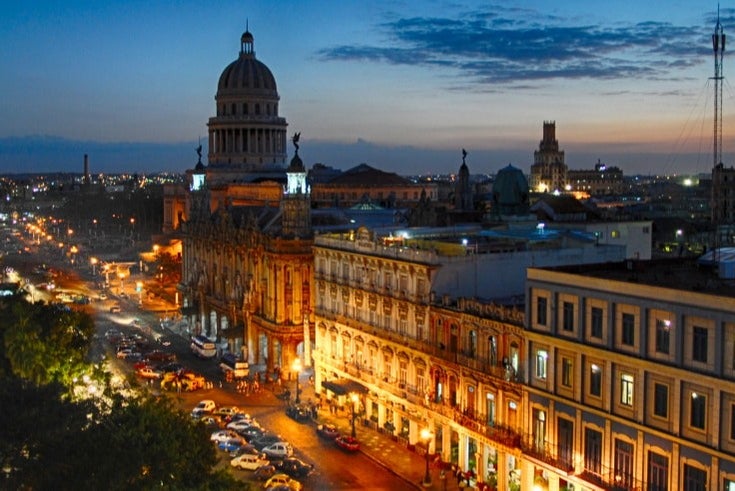
The Hotel Nacional de Cuba was inaugurated on 30 December 1930, standing on the Taganana hill in front of Havana’s “malecón”. It is a magnificent building in the neighbourhood of El Vedado stitched with chess pieces dedicated to the world champion Cuban chess player José Raúl Capablanca. It exhibits an eclectic architecture mixing art deco, neo-colonial, classical Roman and Spanish Moorish styles; and the use of national materials such as marble, hard and precious woods and jaimanite stones. Its construction was a landmark in the country, as the American construction company Purdy and Henderson used steel beams covered in concrete; this is how the hotel withstood a bombardment on 2 October 1933, due to the confrontation between the deposed officers of the Cuban National Army, who were billeted in the hotel, and the newly promoted enlisted men and officers.
The lobby has been preserved from the 1930s, with lamps, lifts, a postal system, a plaster ceiling, Sevillian tiles that embrace it, sculptures and heritage paintings such as a large painting by the outstanding Domingo Ramos that recreates the Viñales Valley.
The ample and green garden is an oasis within the city with typical Caribbean palm trees; it is a balcony towards Havana and its bay, to enjoy the incredible view of the calm blue sea and to be enraptured by the sea breeze and the delicious cocktails of the nearby bars. It is protected by two ancient cannons, remains of the Spanish Bateria de Santa Clara, which was built on the hill in the 18th century and was part of Havana’s system of fortifications, making it a World Heritage Site. The hotel was also the scene of the defence of the city during the Missile Crisis in 1962, when tunnels, trenches and anti-aircraft emplacements were dug in the garden.
The hotel was also the scene of the Italian-American Mafia, with the Mafia Conference during the last week of 1946, led mainly by Charles “Lucky” Luciano and Mayer Lansky. Subsequently Havana became the gambling capital until the triumph of the Cuban Revolution, led by Fidel Castro Ruz, which eliminated the evils associated with the Mafia.
In the early 1960s the hotel housed hundreds of peasant women from all regions of the country, summoned by the leadership of the Revolution to be taught to read and write and to learn dressmaking and sewing.
The corridors and 426 rooms speak of hundreds of personalities and celebrities who have left their mark on the hotel such as Errol Flynn, Frank Sinatra, Ava Gardner, Johnny Welsmuller (Tarzan); Rita Hayworth, Fred Astaire, Gary Cooper, Walt Disney, Winston Churchill, Nat King Cole, María Félix, Jorge Negrete, Agustín Lara, Pedro Vargas, Mario Moreno (Cantinflas), Lola Flores, Ernest Hemingway, Joséphine Baker, Alexander Flemming, Bola de Nieve, Jean Paul Sartre, Yuri Gagarin, Sarita Montiel and Compay Segundo, more than 300 celebrity faces grace the hotel’s Hall of Fame, including more than 100 presidents such as Vladimir Putin, Hugo Chavez, Xi Jinping, François Hollande and Jimmy Carter.
Due to the preservation of its architectural, historical and heritage values, the hotel was inscribed on the Memory of the World Register by the Cuban National Commission for UNESCO.
The Hotel Nacional de Cuba lives in the XXI century and offers 5 star services to guests and visitors, its rooms are comfortably equipped, being superior the ones offered as Executive Service and standing out among them the Presidential Suite and the Royal Suite. There are three restaurants, a cafeteria, four bars and a snack bar. There are two swimming pools, a tennis court and an observation deck in one of its domes. There are 10 elegant and multifunctional rooms for banquets and conventions. It has a spacious car park. It offers barber-hairdresser service, massage, laundry, medical services, customer service and currency exchange. It has a Cuban art gallery, reservation bureau, shopping gallery, car rental and excursion sales agency.
The Cabaret Parisien is part of the hotel and is one of the most select and elegant cabarets in Havana. The tropical night expresses all its splendour and freshness in this place where about 100 dancers and singers show the history of the Cuban music, distinguishing their musical shows by the respect to the Antillean roots.
BOOK NOW